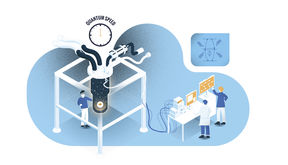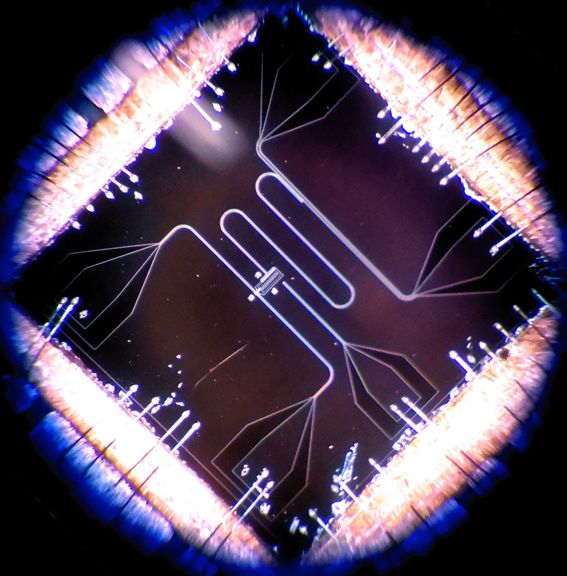Life on the edge in the quantum world - Taking shortcuts and driving at the quantum speed limit

Quantum physics sets the laws that dominate the universe at the very small scale. The ability to harness quantum phenomena will hopefully allow us to build machines like quantum computers, which are predicted to perform certain calculations much faster than conventional computers. One major problem with building quantum processors is that the ability to track and control quantum systems in real-time is an overwhelmingly fragile task: if we try to manipulate these systems carelessly, significant errors get introduced in the final result. New work by a team at Aalto hopefully means we can carry out these delicate operations as quickly as possible.
To get to this point, the researchers controlled quantum phenomena in a custom-designed electrical circuit called a transmon (see Figure). When we chill a transmon chip to within a few thousandths of a degree above absolute zero, the device enters the quantum world, and starts to behave like an artificial atom. One of the quantum features that interests researchers is that the energy of the transmon can only take specific values, called energy levels. The energy levels are like steps on a ladder: a person climbing the ladder has to stop on a step, and can’t hover somewhere in-between two steps. Likewise, the energy the transmon has can only can only be the set values of the energy levels. When we shine microwaves on the circuit, the transmon can absorb the energy and climb up the rungs of the ladder.
In work published 8 February in the journal Science Advances, a group from Aalto University led by Docent Sorin Paraoanu, Senior University Lecturer in the Department of Applied Physics, has been able to make the transmon jump more than one energy level in one go. Previously, this has been possible only by very gentle and slow adjustments of the microwave signals that control the device. In the new work, an additional microwave control signal shaped in a very specific way allows a very precise and fast change of the energy level. Dr. Antti Vepsäläinen, the lead author, explains: ‘We have a saying in Finland: “hiljaa hyvää tulee” (slowly does it). But we managed to show that by correcting continuously the state of the system, we can drive this process more rapidly and at high fidelity.

Dr. Sergey Danilin, one of the coauthors, describes quantum control – the process of using chips like transmons to build quantum computers – by extending the “climbing a ladder” analogy. ‘To get a useful quantum system, you need to imagine climbing a ladder while holding a glass of water, it works if one does it smoothly – but if you do it too fast the water will be spilled. Certainly this requires a special skill.’ The researchers found that in the quantum word the trick for climbing the ladder quickly without spilling any water is by carefully jumping two rungs at a time! This short-cut up the energy ladder was achieved by making the transmon absorb two different microwave photons at the same time. The laws of nature put a restriction on how fast any quantum energy switch can take place, even with short-cuts and this restriction is called the quantum speed limit. To their delight, the Aalto scientists found that their new method resulted in changes to the energy level that took place at speeds that were close to this theoretically calculated limit.
The wider impact of being able to control high speed energy transfers in quantum systems are also exciting to the team. Of potentially high importance are quantum computing and quantum simulation applications, which requires fast and highly robust operations such as state preparation and the creation of quantum gates. Dr. Paraoanu sees opportunities developing in other directions as well: ‘We would like to understand more deeply the processes related to energy transfer, which are ubiquitous in the natural world and in the technological marvels that surround us. For example, are there any fundamental limits to how fast we can charge the battery of an electric car?’ In the rapidly-developing field of quantum technologies, it is possible that this new control method will find multiple applications.
Full Reference:
A. Vepsäläinen, S.Danilin, and G.S. Paraoanu "Superadiabatic population
transfer in a three-level superconducting circuit"
Science Advances 5, eaau5999 (2019).
DOI: 10.1126/sciadv.aau5999
Note to editors:
The research team is part of the national centre of excellence – Quantum Technology Finland, funded by the Academy of Finland. The experimental research was carried out at the national OtaNano research infrastructure for micro, nano, and quantum technologies.
- Published:
- Updated:
Read more news

Camilla Hollanti elected as a member of Finnish Academy of Science and Letters
Camilla Hollanti leads a prominent research group on applications of algebra and number theory. The central topic of her research is to apply the methods of algebra and number theory to problems encountered in communication systems. Applications include wireless security and secure distributed computation.
Aalto ARTS alum Vidha Samya’s artwork featured at the Venice Biennale 2024
The Pavilion of Finland presents ‘The pleasures we choose’ at the 60th International Art Exhibition – La Biennale di Venezia until 24 November 2024.
IoT Forge donates EUR 1 million to the School of Engineering
The donation will be used for research and education on the Industrial Internet and digital twins.